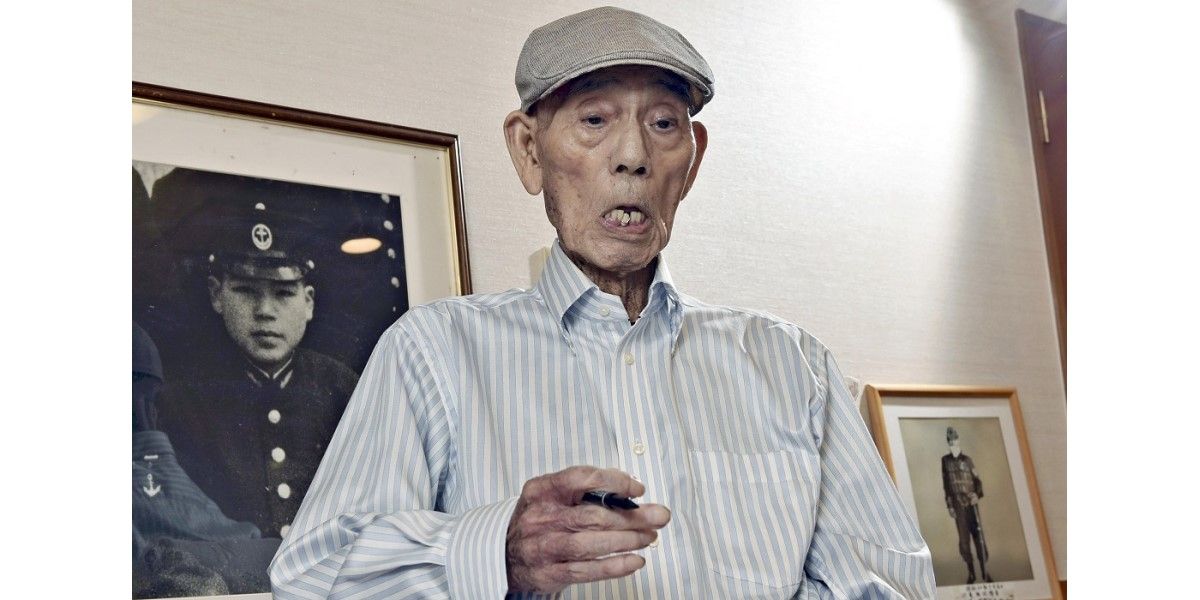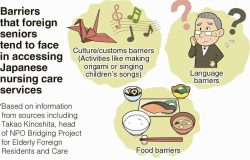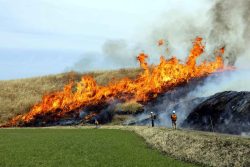
Diving equipment for a “Fukuryu” human mine
14:38 JST, August 14, 2023
Russia’s aggression against Ukraine has illustrated how brutally war takes the lives and crushes the minds of countless people. Many Japanese people witnessed this during World War II, and the remaining survivors have become increasingly enraged by the tragedies occurring around the world.
“In, out. In, out…” Inhaling through the nose, then exhaling through the mouth regularly, like a machine. In July this year, 93-year-old Michiro Suzuki re-created a certain breathing method at a nursing home in Kani, Gifu Prefecture.
“Make a mistake and you’ll die from lack of oxygen.” Suzuki could never forget that breathing technique, which was hammered home in the training he underwent during the war.
Suzuki was to be sent to the shallow sea bottom, and if an enemy ship came overhead, he was to poke it with a stick tipped with a mine. This special weapon was called “Fukuryu” and was meant for fighting on mainland Japan, with no hope for survival.

Michiro Suzuki talks about “Fukuryu” human mines in Kani, Gifu Prefecture, on July 19. The photos behind Suzuki are of him as a young flight trainee.
At the age of just 14, Suzuki volunteered in January 1945 to become a flight trainee and was assigned to the Okazaki Naval Air Squadron in Aichi Prefecture.
Around that time, U.S. forces had landed in the Philippines, while U.S. B-29 bombers were flying over Tokyo. The Japanese were being driven into a corner as Zero fighters mounted with bombs began suicide attacks on U.S. aircraft carriers.
One day, Suzuki was ordered to line up with his fellow trainees. “We’re recruiting people who want to join the special attack units. Volunteers, step forward.” When the divisional officer urged them to do so, he heard the person next to him swallowing a gulp. Suzuki’s mother’s face flashed across his mind, but he found himself stepping out of the line.
He was sent by railway not to an air base, but an anti-submarine school in Yokosuka, Kanagawa Prefecture. The superior officer declared, “You bastards are members of a human mine unit.”
The diving gear weighed as much as 80 kilograms. With an iron diving helmet on, the breath they expelled from their mouth was sent through a tube to a cleaning can on their back. The gear was arranged so the diver could continue to breathe in the water, with the sodium hydroxide — a toxic substance — in the can absorbing carbon dioxide.
However, the thin metal cleaning can could easily crack if it hit a rock. Should seawater get in, the sodium hydroxide would react chemically to form a high-temperature, aqueous solution that could severely burn the wearer’s face.
The hastily prepared training for the Fukuryu human mine involved the constant fear of death.
The diving drill would begin with a high-pitched “clang, clang” when the helmet was rapped on. On hearing it, Suzuki would instinctively shut his eyes tightly.
His mother’s face would flash across his mind, encouraging him. “Do your best, son. Mother is watching you.”
He made a mistake once during the diving process and became unconscious in a “diving crash,” or sudden descent. A fellow diver who was holding the lifeline sensed that something was wrong and pulled Suzuki up, narrowly saving him from death.
That diver later lost his life in an accident during the drills. There was no response from him to the lifeline, so Suzuki pulled him up and removed his helmet, only to find that his eyes had popped out.
Every time a hammock in the barracks became vacant, he thought, “Another trainee has died.”
Fukuryu was never deployed in actual fighting, but many young men fell victim to the reckless training.
On Aug. 15, 1945, Suzuki heard the broadcast of the Emperor announcing Japan’s surrender and learned that Japan was defeated. He only felt the war was truly over after he made it to his hometown in Gifu Prefecture and threw a grenade he had brought back into a deep pool of a local river. He felt that he had finally left the military.
Suzuki worked as an elementary school teacher in the prefecture and continued to give lectures in his hometown after retiring. He told his listeners: “My fellow trainees died miserable deaths in accidents involving ridiculous weapons. This must not be repeated.”
As his body weakened with age, Suzuki became unable to pass his story down to the younger generations. As Russia’s armed aggression against Ukraine continues, it has been said that the Russian military is running short of ammunition and has been engaging in hand-to-hand combat using tools.
“I can only think that they [the Russian military] have been governed by madness. I wish I could convey more about the horror of war. It’s a pity,” Suzuki said during an interview with The Yomiuri Shimbun on July 19.
On the evening of Aug. 7, Suzuki died at his home in Tajimi, Gifu Prefecture. According to his eldest daughter, Atsuyo, 58, his pulse gradually weakened and he passed away like he was falling asleep at his beloved home.
Yet another person who experienced the war has died.
6,371 special force members
According to government estimates, approximately 2.3 million Japanese military personnel and civilians in military service died in the Asia-Pacific War. In the last months of the war, the Japanese military developed a variety of weaponry for special attack units, better known as tokkotai, and forced personnel in the field to fight recklessly.
According to the “association for commending those members of tokkotai who died in war,” a public interest incorporated foundation based in Tokyo, 6,371 members of special attack units were killed in action: 4,146 in the navy and 2,225 in the army.
With the international situation becoming ever-more unstable, experts say it is necessary to reexamine the background behind the suicide attack missions.
German and Soviet forces also carried out suicide attacks during World War II, said Tokyo International University Professor Tomohide Murai, a scholar of military history and co-author of “The Essence of Failures,” a book analyzing the causes of the Japanese military’s defeat in the war.
“If weapons and fuel become scarce during wartime, suicide attacks become an option, which may result in more tragedy,” Murai said. “To prevent this from happening, we need to learn from history.”
"JN Specialities" POPULAR ARTICLE
-

The Japan News / Weekly Edition (12/12-12/18)
-

Noodle Dining Shunsai / Rich Oyster Ramen to Savor at Odasaga; Experienced 68-year-old Owner Creates Numerous Ramen Varieties
-

The Japan News / Weekly Edition (12/5-12/11)
-

People Keep Loved Ones’ Ashes Close in Special Jewelry, Small Urns as Unique Way to Memorialize Them
-

The Japan News / Weekly Edition (12/19-12/25)
JN ACCESS RANKING
-

Tokyo Economic Security Forum to Hold Inaugural Meeting Amid Tense Global Environment
-

Keidanren Chairman Yoshinobu Tsutsui Visits Kashiwazaki-Kariwa Nuclear Power Plant; Inspects New Emergency Safety System
-

Imports of Rare Earths from China Facing Delays, May Be Caused by Deterioration of Japan-China Relations
-

University of Tokyo Professor Discusses Japanese Economic Security in Interview Ahead of Forum
-

Japan Pulls out of Vietnam Nuclear Project, Complicating Hanoi’s Power Plans



























